Global Butylated Hydroxytoluene Market Forecast
- The US$0.2 Bn market for BHT likely to reach up to US$0.3 Bn by 2030-end
- Market size projected to exhibit a CAGR of 5.8% during 2023 - 2030
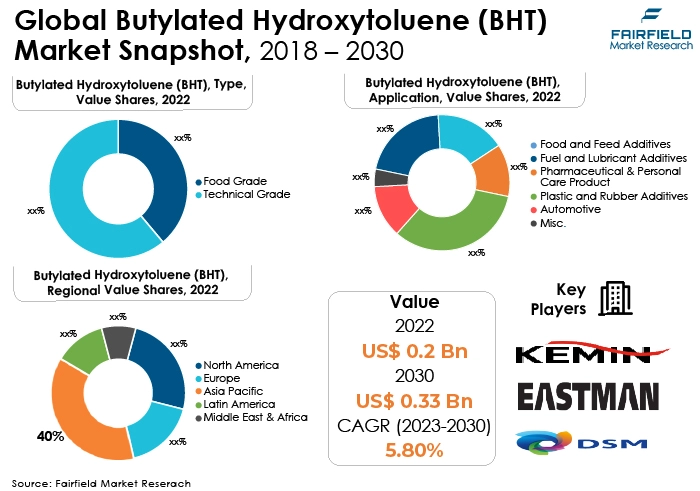
Quick Report Digest
- The popularity of natural and organic goods is one of the most noticeable trends in the butylated hydroxytoluene market. Consumers' increased interest in natural ingredients and health consciousness drive this trend.
- The rising need for reasonably priced goods is a significant trend in the butylated hydroxytoluene market. This is particularly true in developing nations, where economic expansion produces a larger middle class with greater disposable income.
- In 2022, the technical grade category generated the most market revenue. In general, the production of BHT is less expensive than that of natural alternatives. By efficiently applying recognised chemical procedures, BHT can be produced on a wide scale while minimising costs.
- It is expected that the food grade category will grow the fastest. A growing market for items that are clean and secure. The demand for food grade antioxidants has increased among people because of people trying to avoid negative side effects and difficulties.
- In 2022 the plastic and rubber additives sector had the largest market share. Numerous industries, including automotive, building, packaging, and consumer products, use rubber and plastic substantially.
- Over the projected period, the food and feed additives category is anticipated to increase the fastest. The flavour and nutritional value of the food are both preserved, increasing consumer demand. Advanced additives also help to maintain the taste and freshness of food goods.
- The Asia Pacific region accounts for the largest share of the global butylated hydroxytoluene market owing to the expansion of the food and beverages industry and the region's growing appetite for processed foods. Additionally, a sizable number of small and medium-sized businesses (SMEs) in China is another important element fuelling the market's expansion.
- North America will have the quickest rate of growth in the butylated hydroxytoluene market during the forecast period. The rising food and beverage sector and the rising demand for processed foods drive the North American butylated hydroxytoluene market.
A Look Back and a Look Forward - Comparative Analysis
Increased demand from numerous end-user sectors, including plastics, food & beverages, animal care, personal care, lubricants, agrochemicals, and biodiesel, is one of the factors driving the considerable growth of the global butylated hydroxytoluene market. Additionally, throughout the beginning of the forecast period, rising consumer worries about water pollution and a rising trend of wastewater recycling are predicted to expand the footprint of the global butylated hydroxytoluene market.
In the middle of the 20th century, the butylated hydroxytoluene became well-liked as a food preservative. It was widely used in the food business to increase the shelf-life of goods. Additionally, it served as an antioxidant in the petrochemical, cosmetic, and pharmaceutical industries. Furthermore, worries about its security and possible health dangers have grown over time. Regulatory agencies constrained its use in specific applications in several nations.
The companies in the market for BHT may regard the increase in demand in small industries as a potential opportunity. Antioxidants are widespread in the cosmetics, food, beverage, and animal feed industries. Furthermore, higher R&D expenditures for creating improved goods are anticipated to drive the global butylated hydroxytoluene market in the coming years.
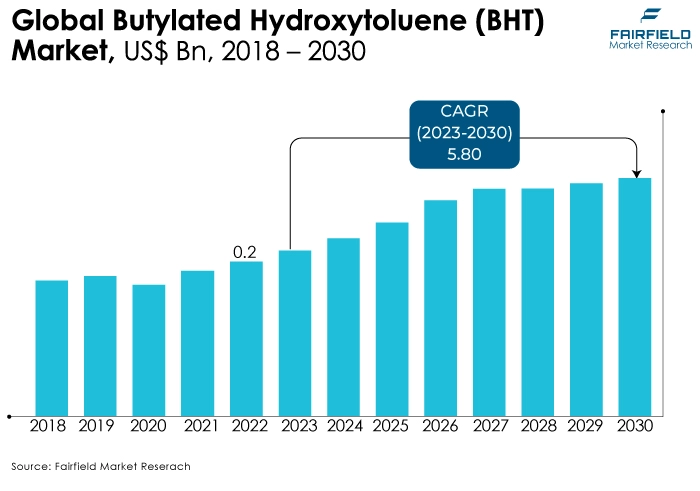
Key Growth Determinants
- Ascending Uptake by Processed Food Sector
In the food and beverage industry, antioxidants BHT are still rising and are now regarded as a crucial addition. The ingredient is now widely used due to rising consumer knowledge of its several advantages in reducing chronic diseases like diabetes.
Market growth has been impacted by the rising demand for and consumption of processed foods, which frequently include antioxidant chemicals. Its presence keeps the food from oxidising and increases its shelf-life. People's dependency on processed foods is increasing due to the growing working population and their fast-paced lifestyle.
- Cosmetic and Personal Care Industry’s Growing Interest
BHT is used as an antioxidant in cosmetics and personal care products more frequently because of its ability to prolong product shelf-life and protect against oxidation. Additionally, as consumers' disposable income has improved, they have been able to invest in high-end personal care products, and the popularity of men's grooming product lines has enhanced consumer acceptance of these products in the cosmetics sector.
According to data from Euromonitor International, the industry for cosmetics and personal care goods grew by 4% in 2021 to reach a value of US$532 Bn. By 2024, the market is projected to have grown further, reaching a value of US$641 Bn.
- Rising Application in Antioxidants BHT in Plastics and Rubber Sector
Due to its antioxidant properties, antioxidants BHT are frequently employed in the plastics and rubber industries, and throughout the projection period, this use is anticipated to increase significantly. Antioxidants were formerly applied to rubber to prevent oxidation; however, oxidation will occur on the exposed rubber as soon as the protective coating is removed. Chemicals are added to the rubber during mixing instead of coating the rubber surface to prevent this.
Antioxidants interact with oxygen trapped in the rubber compounds during mechanical mixing and then bleed to the surface, completely shielding rubber from oxidation. Additionally, it is anticipated that throughout the projection period, the market for butylated hydroxytoluene will be driven by the rising demand for plastics and rubber from numerous industries, including the automotive and packaging sectors.
Major Growth Barriers
- Customer Preference for Natural Alternatives
As more people look for natural and clean-label products, antioxidants derived from natural ingredients-like vitamins C and E-rather than technical grade ones-like BHT, are becoming increasingly popular. This change in consumer demand may restrict market expansion.
- Potential Health Hazards
Butylated hydroxytoluene has been connected to several health issues, including cancer-causing effects, endocrine disruption, and developmental and reproductive toxicity. In addition, it has been discovered that topical administration of the butylated hydroxytoluene can harm lung tissue and liver and kidney damage. These factors limit the market by reducing the demand for and sales of BHT.
Key Trends and Opportunities to Look at
- Greater Emphasis on Skin Health
Antioxidants like BHT are becoming more popular due to the greater attention paid to skin health. BHT and other antioxidants are thought to aid in preventing oxidative damage to the skin, which can speed up the aging process.
The significance of safeguarding skin health is thus growing in consumer and key player awareness. As a result, there is a rising need for butylated hydroxytoluene goods intended to enhance skin health.
- Greater Emphasis on Environmentally Sustainable Goods
The rise in eco-friendly and environmentally conscious product providers in the butylated hydroxytoluene market reflects a broader trend toward sustainability and environmental awareness in many other industries. The environmental effect of consumer purchases, such as skincare and personal care items, is becoming increasingly a concern for shoppers.
This could entail employing sustainable sourcing practices, cutting down on packaging waste, or looking into less hazardous antioxidants to the environment, like in the case of the butylated hydroxytoluene.
- Extensive Use in Animal Feed Sector
The necessity to retain the nutritional value and freshness of animal feed ingredients has led to the widespread application of antioxidants like BHT in the animal feed industry. To avoid rancidity and a reduction in the nutritional content of the feed, antioxidants are added to animal diets to stop fats and oils from oxidising.
The animal feed industry can guarantee that the feed is tasty, secure, and nutrient-sufficient for livestock, poultry, and other animals by utilising antioxidants like BHT.
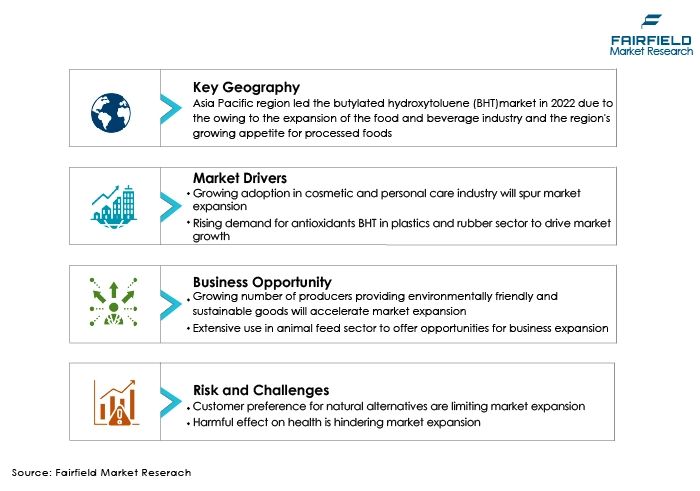
How Does the Regulatory Scenario Shape this Industry?
The regulatory environment in the butylated hydroxytoluene (BHT) antioxidant sector can greatly impact the industry's production, sales, and use. Global regulatory agencies, including the European Food Safety Authority (EFSA) and the U.S. Food and Drug Administration (FDA), have approved BHT as a food additive. This regulatory authorisation guarantees the safe application of BHT as a food preservative.
According to estimates from the Food and Agriculture Organization (FAO), over one-third of the worldwide food is lost or wasted yearly. BHT is a food preservative that can aid in reducing food waste and deterioration.
Additionally, regulatory agencies set MRLs for pesticide residues in crops, including BHT. For agricultural techniques to guarantee the safety of the food produced, adherence to these boundaries is essential. Furthermore, using antioxidants BHT in specific applications may be prohibited in some nations or regions. For instance, there can be restrictions on the maximum permitted BHT concentration in cosmetics or food items.
Fairfield’s Ranking Board
Top Segments
- Technical Grade Category Maintains a Dominant Position
The technical grade segment dominated the market in 2022. Chemical synthesis is utilised to create technical-grade antioxidants BHT, widely applied in food, feed, fuel, and other industries. Depending on the region and the kind of food it is utilised in different technical grade substances have different upper limits that can be found in food.
Due to its extensive availability and inexpensive prices, the category is projected to hold most of the market share. Furthermore, the food grade category is projected to experience the fastest market growth.
With customers' increased preference for safer and cleaner-label products, there is an increase in demand for natural butylated hydroxytoluene components. The food-grade antioxidants BHT category is smaller than the technical grade antioxidants market, but it has great potential to overtake it in the coming years.
- Plastic and Rubber Additives Surge Ahead
The plastic and rubber additives category is quite profitable and has widespread use. They are applied to plastic products to stop thermo-mechanical or thermo-oxidative conditions from causing degradation. They also aid in improving the product's flexibility, strength, stiffness, and aesthetics. One of the key factors propelling the market in the upcoming years is an increase in demand for these items.
Furthermore, the food and feed additives category is expected to grow significantly due to the rising demand for the additive in various meat, poultry, and animal food items. They are added to improve the nutritional value, flavour, freshness, and odour of the food and feed. Additionally, the growing food industry is predicted to support market expansion.
Regional Frontrunners
Asia Pacific at the Top
The Asia Pacific region's butylated hydroxytoluene market is anticipated to command a 45% revenue share. The region's expanding urbanisation, rising population, and changing lifestyles in developing countries like China, and India are among the factors contributing to the growth of this industry.
Additionally, it is anticipated that demand for butylated hydroxytoluene will rise during the next five years due to Asia Pacific's growing food and beverage industry. Moreover, cosmetics, medicines, and plastics are just a few of the businesses in the area that use antioxidants BHT extensively.
Plastic and rubber goods are produced in large quantities throughout the Asia Pacific region. According to the Asia Petrochemical Industry Conference, the Asia Pacific region produced and used almost 50% of all plastics worldwide in 2019. The butylated hydroxytoluene shields rubber and plastics from heat and UV ray-induced deterioration.
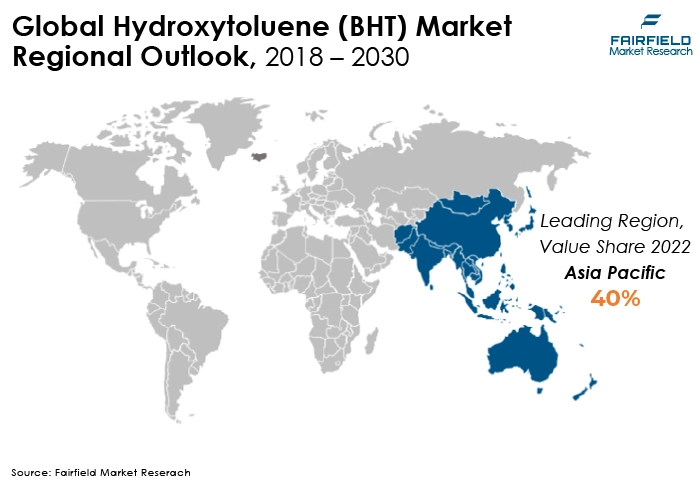
Prospects of North America Grow Strong
Over the forecast period, the market for butylated hydroxytoluene is anticipated to develop at the quickest rate in the North American region. Numerous industries, including those that consume a substantial amount of the butylated hydroxytoluene, such as those in the food and beverages, cosmetics, plastics, rubber, and pharmaceutical sectors, have expanded due to this rise. The dominance of the butylated hydroxytoluene market has been propelled by the rising demand for processed foods, consumer goods, and industrial items in this region.
Additionally, as a food additive and cosmetic ingredient, BHT has received approval from North American regulatory agencies, such as the US Food and Drug Administration (FDA), and Health Canada. This approval ensures its safe usage in various businesses. The food and beverage sector is highly developed and diverse in North America.
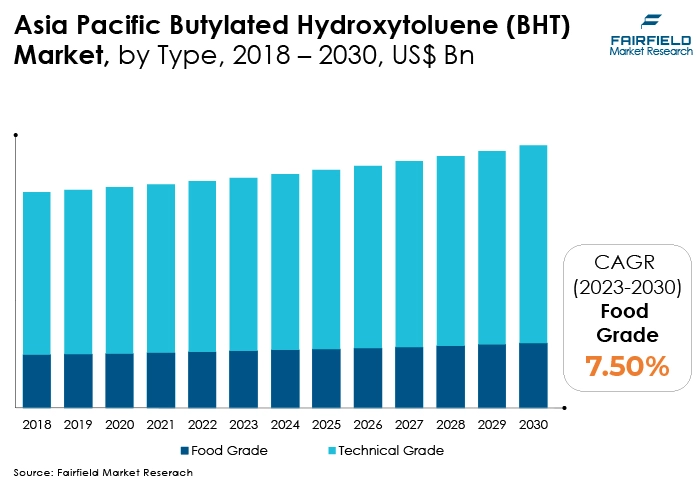
Fairfield’s Competitive Landscape Analysis
Fairfield Market Research expects that top companies will concentrate on tactics like product innovations, mergers and acquisitions, most recent advances, joint ventures, collaborations, and partnerships to capture a sizeable market share in the global butylated hydroxytoluene market.
Who are the Leaders in Global Butylated Hydroxytoluene Space?
- Kemin Industries Inc.
- BASF SE
- Koninklijke DSM N.V.
- Eastman Chemical Company
- Kalsec Inc.
- Archer-Daniels-Midland Company
- Barentz Group
- Adisseo
- International Flavors & Fragrances Inc.
- DuPont de Nemours Inc.
- LANXESS
- Cargill
- Perstorp Group
- Caldic
- Impextraco
- Charles Bowmen & Company
- T.J Clark & Company
- Shandong Runde Biotechnology Co.
- Howtian
Significant Company Developments
New Product Launches
- April 2021: For the EMENA (Europe, Middle East, North Africa) region's organic livestock production sector, Kemin Industries has introduced Paradigmox Green, a new antioxidant solution.
- February 2021: SkinCeuticals, a skincare company based in Texas, recently unveiled a new antioxidant serum for oily skin.
Distribution Agreements
- December 2020: Using BHT as an antioxidant in specific food products consumed by babies and young children is subject to upper limitations set by a temporary order issued by Health Canada. This temporary decree will be in force from March 1, 2021, to December 31, 2025.
- November 2020: Japan's Ministry of Health, Labour, and Welfare has permitted the butylated hydroxytoluene to be used there. With this certification, butylated hydroxytoluene's global reach was significantly expanded.
- July 2020: BHT, as an antioxidant, has been given GRAS (Generally Recognized as Safe) designation by the US FDA for use as a food additive. This finding was noteworthy because it gave butylated hydroxytoluene new applications in the food and beverage sector.
- In 2021: Kemin Industries announced its partnership with the DKSH Business Unit over the distribution of its goods in Myanmar, Vietnam, and Cambodia. Because of this link, the business will be able to expand its current clientele throughout Southeast Asia.
An Expert’s Eye
Demand and Future Growth
As per Fairfield’s Analysis, the global market for butylated hydroxytoluene has grown significantly due to the expansion of the cosmetics sector because it is used as a stabilizer in cosmetics.
Furthermore, using butylated hydroxytoluene as an animal feed to counter disease resistance in animals is what is driving the industry. The market will also grow due to the demand for technical grade antioxidants, which preserve food goods and increase their shelf-life.
Supply Side of the Market
According to our analysis, to extend the shelf-life of processed foods, manufacturers operating in the butylated hydroxytoluene market are concentrating on increasing the use of food preservatives in processed food. The use of natural preservatives derived from plant and animal sources is currently on the rise in the market for food preservatives.
In the past, technical grade preservatives were preferred because of their effectiveness. Recently, consumers have started to favour foods that are natural, organic, or free of preservatives. The food business is, therefore, attempting to create preservatives that are just as effective as natural ones.
In addition, butylated hydroxytoluene is used in the pharmaceutical industry due to several variables, including its use as an antioxidant and stabilizer in pharmaceutical products. Pharmaceutical formulations' quality and effectiveness are maintained, and drug deterioration is prevented.
According to a study published in the International Journal of Pharmacy and Pharmaceutical Sciences, BHT effectively extended the shelf-life and stability of a medicine formulation containing a delicate active ingredient.
Global Butylated Hydroxytoluene Market is Segmented as Below:
By Type
- Food Grade
- Technical Grade
By Application
- Food and Feed Additives
- Fuel and Lubricant Additives
- Pharmaceutical and Personal Care Products
- Plastic and Rubber Additives
- Automotive Products
- Miscellaneous
By Geographic Coverage:
- North America
- U.S.
- Canada
- Europe
- Germany
- U.K.
- France
- Italy
- Turkey
- Russia
- Rest of Europe
- Asia Pacific
- China
- Japan
- South Korea
- India
- Southeast Asia
- Rest of Asia Pacific
- Latin America
- Brazil
- Mexico
- Argentina
- Rest of Latin America
- Middle East & Africa
- GCC
- South Africa
- Egypt
- Nigeria
- Rest of Middle East & Africa
1. Executive Summary
1.1. Global Butylated Hydroxytoluene (BHT) Market Snapshot
1.2. Future Projections
1.3. Key Market Trends
1.4. Regional Snapshot, by Value, 2022
1.5. Analyst Recommendations
2. Market Overview
2.1. Market Definitions and Segmentations
2.2. Market Dynamics
2.2.1. Drivers
2.2.2. Restraints
2.2.3. Market Opportunities
2.3. Value Chain Analysis
2.4. Porter’s Five Forces Analysis
2.5. COVID-19 Impact Analysis
2.5.1. Supply
2.5.2. Demand
2.6. Impact of Ukraine-Russia Conflict
2.7. Economic Overview
2.7.1. World Economic Projections
2.8. PESTLE Analysis
3. Global Butylated Hydroxytoluene (BHT) Market Outlook, 2018 - 2030
3.1. Global Butylated Hydroxytoluene (BHT) Market Outlook, by Type, Value (US$ Bn), 2018 - 2030
3.1.1. Key Highlights
3.1.1.1. Food Grade
3.1.1.2. Technical Grade
3.2. Global Butylated Hydroxytoluene (BHT) Market Outlook, by Application, Value (US$ Bn), 2018 - 2030
3.2.1. Key Highlights
3.2.1.1. Food and Feed Additives
3.2.1.2. Fuel and Lubricant Additives
3.2.1.3. Pharmaceutical and Personal Care Products
3.2.1.4. Plastic and Rubber Additives
3.2.1.5. Automotive Products
3.2.1.6. Miscellaneous
3.3. Global Butylated Hydroxytoluene (BHT) Market Outlook, by Region, Value (US$ Bn), 2018 - 2030
3.3.1. Key Highlights
3.3.1.1. North America
3.3.1.2. Europe
3.3.1.3. Asia Pacific
3.3.1.4. Latin America
3.3.1.5. Middle East & Africa
4. North America Butylated Hydroxytoluene (BHT) Market Outlook, 2018 - 2030
4.1. North America Butylated Hydroxytoluene (BHT) Market Outlook, by Type, Value (US$ Bn), 2018 - 2030
4.1.1. Key Highlights
4.1.1.1. Food Grade
4.1.1.2. Technical Grade
4.2. North America Butylated Hydroxytoluene (BHT) Market Outlook, by Application, Value (US$ Bn), 2018 - 2030
4.2.1. Key Highlights
4.2.1.1. Food and Feed Additives
4.2.1.2. Fuel and Lubricant Additives
4.2.1.3. Pharmaceutical and Personal Care Products
4.2.1.4. Plastic and Rubber Additives
4.2.1.5. Automotive Products
4.2.1.6. Miscellaneous
4.2.2. Market Attractiveness Analysis
4.3. North America Butylated Hydroxytoluene (BHT) Market Outlook, by Country, Value (US$ Bn), 2018 - 2030
4.3.1. Key Highlights
4.3.1.1. U.S. Butylated Hydroxytoluene (BHT) Market by Type, Value (US$ Bn), 2018 - 2030
4.3.1.2. U.S. Butylated Hydroxytoluene (BHT) Market, by Application, Value (US$ Bn), 2018 - 2030
4.3.1.3. Canada Butylated Hydroxytoluene (BHT) Market by Type, Value (US$ Bn), 2018 - 2030
4.3.1.4. Canada Butylated Hydroxytoluene (BHT) Market, by Application, Value (US$ Bn), 2018 - 2030
4.3.2. BPS Analysis/Market Attractiveness Analysis
5. Europe Butylated Hydroxytoluene (BHT) Market Outlook, 2018 - 2030
5.1. Europe Butylated Hydroxytoluene (BHT) Market Outlook, by Type, Value (US$ Bn), 2018 - 2030
5.1.1. Key Highlights
5.1.1.1. Food Grade
5.1.1.2. Technical Grade
5.2. Europe Butylated Hydroxytoluene (BHT) Market Outlook, by Application, Value (US$ Bn), 2018 - 2030
5.2.1. Key Highlights
5.2.1.1. Food and Feed Additives
5.2.1.2. Fuel and Lubricant Additives
5.2.1.3. Pharmaceutical and Personal Care Products
5.2.1.4. Plastic and Rubber Additives
5.2.1.5. Automotive Products
5.2.1.6. Miscellaneous
5.2.2. BPS Analysis/Market Attractiveness Analysis
5.3. Europe Butylated Hydroxytoluene (BHT) Market Outlook, by Country, Value (US$ Bn), 2018 - 2030
5.3.1. Key Highlights
5.3.1.1. Germany Butylated Hydroxytoluene (BHT) Market by Type, Value (US$ Bn), 2018 - 2030
5.3.1.2. Germany Butylated Hydroxytoluene (BHT) Market, by Application, Value (US$ Bn), 2018 - 2030
5.3.1.3. U.K. Butylated Hydroxytoluene (BHT) Market by Type, Value (US$ Bn), 2018 - 2030
5.3.1.4. U.K. Butylated Hydroxytoluene (BHT) Market, by Application, Value (US$ Bn), 2018 - 2030
5.3.1.5. France Butylated Hydroxytoluene (BHT) Market by Type, Value (US$ Bn), 2018 - 2030
5.3.1.6. France Butylated Hydroxytoluene (BHT) Market, by Application, Value (US$ Bn), 2018 - 2030
5.3.1.7. Italy Butylated Hydroxytoluene (BHT) Market by Type, Value (US$ Bn), 2018 - 2030
5.3.1.8. Italy Butylated Hydroxytoluene (BHT) Market, by Application, Value (US$ Bn), 2018 - 2030
5.3.1.9. Turkey Butylated Hydroxytoluene (BHT) Market by Type, Value (US$ Bn), 2018 - 2030
5.3.1.10. Turkey Butylated Hydroxytoluene (BHT) Market, by Application, Value (US$ Bn), 2018 - 2030
5.3.1.11. Russia Butylated Hydroxytoluene (BHT) Market by Type, Value (US$ Bn), 2018 - 2030
5.3.1.12. Russia Butylated Hydroxytoluene (BHT) Market, by Application, Value (US$ Bn), 2018 - 2030
5.3.1.13. Rest of Europe Butylated Hydroxytoluene (BHT) Market by Type, Value (US$ Bn), 2018 - 2030
5.3.1.14. Rest of Europe Butylated Hydroxytoluene (BHT) Market, by Application, Value (US$ Bn), 2018 - 2030
5.3.2. BPS Analysis/Market Attractiveness Analysis
6. Asia Pacific Butylated Hydroxytoluene (BHT) Market Outlook, 2018 - 2030
6.1. Asia Pacific Butylated Hydroxytoluene (BHT) Market Outlook, by Type, Value (US$ Bn), 2018 - 2030
6.1.1. Key Highlights
6.1.1.1. Food Grade
6.1.1.2. Technical Grade
6.2. Asia Pacific Butylated Hydroxytoluene (BHT) Market Outlook, by Application, Value (US$ Bn), 2018 - 2030
6.2.1. Key Highlights
6.2.1.1. Food and Feed Additives
6.2.1.2. Fuel and Lubricant Additives
6.2.1.3. Pharmaceutical and Personal Care Products
6.2.1.4. Plastic and Rubber Additives
6.2.1.5. Automotive Products
6.2.1.6. Miscellaneous
6.2.2. BPS Analysis/Market Attractiveness Analysis
6.3. Asia Pacific Butylated Hydroxytoluene (BHT) Market Outlook, by Country, Value (US$ Bn), 2018 - 2030
6.3.1. Key Highlights
6.3.1.1. China Butylated Hydroxytoluene (BHT) Market by Type, Value (US$ Bn), 2018 - 2030
6.3.1.2. China Butylated Hydroxytoluene (BHT) Market, by Application, Value (US$ Bn), 2018 - 2030
6.3.1.3. Japan Butylated Hydroxytoluene (BHT) Market by Type, Value (US$ Bn), 2018 - 2030
6.3.1.4. Japan Butylated Hydroxytoluene (BHT) Market, by Application, Value (US$ Bn), 2018 - 2030
6.3.1.5. South Korea Butylated Hydroxytoluene (BHT) Market by Type, Value (US$ Bn), 2018 - 2030
6.3.1.6. South Korea Butylated Hydroxytoluene (BHT) Market, by Application, Value (US$ Bn), 2018 - 2030
6.3.1.7. India Butylated Hydroxytoluene (BHT) Market by Type, Value (US$ Bn), 2018 - 2030
6.3.1.8. India Butylated Hydroxytoluene (BHT) Market, by Application, Value (US$ Bn), 2018 - 2030
6.3.1.9. Southeast Asia Butylated Hydroxytoluene (BHT) Market by Type, Value (US$ Bn), 2018 - 2030
6.3.1.10. Southeast Asia Butylated Hydroxytoluene (BHT) Market, by Application, Value (US$ Bn), 2018 - 2030
6.3.1.11. Rest of Asia Pacific Butylated Hydroxytoluene (BHT) Market by Type, Value (US$ Bn), 2018 - 2030
6.3.1.12. Rest of Asia Pacific Butylated Hydroxytoluene (BHT) Market, by Application, Value (US$ Bn), 2018 - 2030
6.3.2. BPS Analysis/Market Attractiveness Analysis
7. Latin America Butylated Hydroxytoluene (BHT) Market Outlook, 2018 - 2030
7.1. Latin America Butylated Hydroxytoluene (BHT) Market Outlook, by Type, Value (US$ Bn), 2018 - 2030
7.1.1. Key Highlights
7.1.1.1. Food Grade
7.1.1.2. Technical Grade
7.2. Latin America Butylated Hydroxytoluene (BHT) Market Outlook, by Application, Value (US$ Bn), 2018 - 2030
7.2.1. Key Highlights
7.2.1.1. Food and Feed Additives
7.2.1.2. Fuel and Lubricant Additives
7.2.1.3. Pharmaceutical and Personal Care Products
7.2.1.4. Plastic and Rubber Additives
7.2.1.5. Automotive Products
7.2.1.6. Miscellaneous
7.2.2. BPS Analysis/Market Attractiveness Analysis
7.3. Latin America Butylated Hydroxytoluene (BHT) Market Outlook, by Country, Value (US$ Bn), 2018 - 2030
7.3.1. Key Highlights
7.3.1.1. Brazil Butylated Hydroxytoluene (BHT) Market by Type, Value (US$ Bn), 2018 - 2030
7.3.1.2. Brazil Butylated Hydroxytoluene (BHT) Market, by Application, Value (US$ Bn), 2018 - 2030
7.3.1.3. Mexico Butylated Hydroxytoluene (BHT) Market by Type, Value (US$ Bn), 2018 - 2030
7.3.1.4. Mexico Butylated Hydroxytoluene (BHT) Market, by Application, Value (US$ Bn), 2018 - 2030
7.3.1.5. Argentina Butylated Hydroxytoluene (BHT) Market by Type, Value (US$ Bn), 2018 - 2030
7.3.1.6. Argentina Butylated Hydroxytoluene (BHT) Market, by Application, Value (US$ Bn), 2018 - 2030
7.3.1.7. Rest of Latin America Butylated Hydroxytoluene (BHT) Market by Type, Value (US$ Bn), 2018 - 2030
7.3.1.8. Rest of Latin America Butylated Hydroxytoluene (BHT) Market, by Application, Value (US$ Bn), 2018 - 2030
7.3.2. BPS Analysis/Market Attractiveness Analysis
8. Middle East & Africa Butylated Hydroxytoluene (BHT) Market Outlook, 2018 - 2030
8.1. Middle East & Africa Butylated Hydroxytoluene (BHT) Market Outlook, by Type, Value (US$ Bn), 2018 - 2030
8.1.1. Key Highlights
8.1.1.1. Food Grade
8.1.1.2. Technical Grade
8.2. Middle East & Africa Butylated Hydroxytoluene (BHT) Market Outlook, by Application, Value (US$ Bn), 2018 - 2030
8.2.1. Key Highlights
8.2.1.1. Food and Feed Additives
8.2.1.2. Fuel and Lubricant Additives
8.2.1.3. Pharmaceutical and Personal Care Products
8.2.1.4. Plastic and Rubber Additives
8.2.1.5. Automotive Products
8.2.1.6. Miscellaneous
8.2.2. BPS Analysis/Market Attractiveness Analysis
8.3. Middle East & Africa Butylated Hydroxytoluene (BHT) Market Outlook, by Country, Value (US$ Bn), 2018 - 2030
8.3.1. Key Highlights
8.3.1.1. GCC Butylated Hydroxytoluene (BHT) Market by Type, Value (US$ Bn), 2018 - 2030
8.3.1.2. GCC Butylated Hydroxytoluene (BHT) Market, by Application, Value (US$ Bn), 2018 - 2030
8.3.1.3. South Africa Butylated Hydroxytoluene (BHT) Market by Type, Value (US$ Bn), 2018 - 2030
8.3.1.4. South Africa Butylated Hydroxytoluene (BHT) Market, by Application, Value (US$ Bn), 2018 - 2030
8.3.1.5. Egypt Butylated Hydroxytoluene (BHT) Market by Type, Value (US$ Bn), 2018 - 2030
8.3.1.6. Egypt Butylated Hydroxytoluene (BHT) Market, by Application, Value (US$ Bn), 2018 - 2030
8.3.1.7. Nigeria Butylated Hydroxytoluene (BHT) Market by Type, Value (US$ Bn), 2018 - 2030
8.3.1.8. Nigeria Butylated Hydroxytoluene (BHT) Market, by Application, Value (US$ Bn), 2018 - 2030
8.3.1.9. Rest of Middle East & Africa Butylated Hydroxytoluene (BHT) Market by Type, Value (US$ Bn), 2018 - 2030
8.3.1.10. Rest of Middle East & Africa Butylated Hydroxytoluene (BHT) Market, by Application, Value (US$ Bn), 2018 - 2030
8.3.2. BPS Analysis/Market Attractiveness Analysis
9. Competitive Landscape
9.1. Manufacturer vs Type/Application Heatmap
9.2. Company Market Share Analysis, 2022
9.3. Competitive Dashboard
9.4. Company Profiles
9.4.1. Kemin Industries Inc. (U.S.)
9.4.1.1. Company Overview
9.4.1.2. Product Portfolio
9.4.1.3. Financial Overview
9.4.1.4. Business Strategies and Development
9.4.2. BASF SE (Germany)
9.4.2.1. Company Overview
9.4.2.2. Product Portfolio
9.4.2.3. Financial Overview
9.4.2.4. Business Strategies and Development
9.4.3. Koninklijke DSM N.V. (Netherlands)
9.4.3.1. Company Overview
9.4.3.2. Product Portfolio
9.4.3.3. Financial Overview
9.4.3.4. Business Strategies and Development
9.4.4. Eastman Chemical Company (U.S.)
9.4.4.1. Company Overview
9.4.4.2. Product Portfolio
9.4.4.3. Financial Overview
9.4.4.4. Business Strategies and Development
9.4.5. Kalsec Inc. (U.S.)
9.4.5.1. Company Overview
9.4.5.2. Product Portfolio
9.4.5.3. Financial Overview
9.4.5.4. Business Strategies and Development
9.4.6. Archer-Daniels-Midland Company (U.S.)
9.4.6.1. Company Overview
9.4.6.2. Product Portfolio
9.4.6.3. Financial Overview
9.4.6.4. Business Strategies and Development
9.4.7. Barentz Group (Netherlands)
9.4.7.1. Company Overview
9.4.7.2. Product Portfolio
9.4.7.3. Financial Overview
9.4.7.4. Business Strategies and Development
9.4.8. Adisseo (France)
9.4.8.1. Company Overview
9.4.8.2. Product Portfolio
9.4.8.3. Financial Overview
9.4.8.4. Business Strategies and Development
9.4.9. International Flavors & Fragrances Inc. (U.S.)
9.4.9.1. Company Overview
9.4.9.2. Product Portfolio
9.4.9.3. Financial Overview
9.4.9.4. Business Strategies and Development
9.4.10. DuPont de Nemours Inc. (US)
9.4.10.1. Company Overview
9.4.10.2. Product Portfolio
9.4.10.3. Financial Overview
9.4.10.4. Business Strategies and Development
9.4.11. LANXESS (Germany)
9.4.11.1. Company Overview
9.4.11.2. Product Portfolio
9.4.11.3. Financial Overview
9.4.11.4. Business Strategies and Development
9.4.12. Cargill (U.S.)
9.4.12.1. Company Overview
9.4.12.2. Product Portfolio
9.4.12.3. Financial Overview
9.4.12.4. Business Strategies and Development
9.4.13. Perstorp Group (Sweden)
9.4.13.1. Company Overview
9.4.13.2. Product Portfolio
9.4.13.3. Financial Overview
9.4.13.4. Business Strategies and Development
9.4.14. Caldic (Netherlands)
9.4.14.1. Company Overview
9.4.14.2. Product Portfolio
9.4.14.3. Financial Overview
9.4.14.4. Business Strategies and Development
9.4.15. Impextraco (Belgium)
9.4.15.1. Company Overview
9.4.15.2. Product Portfolio
9.4.15.3. Financial Overview
9.4.15.4. Business Strategies and Development
9.4.16. Charles Bowmen & Company (US)
9.4.16.1. Company Overview
9.4.16.2. Product Portfolio
9.4.16.3. Financial Overview
9.4.16.4. Business Strategies and Development
9.4.17. T.J Clark & Company (US)
9.4.17.1. Company Overview
9.4.17.2. Product Portfolio
9.4.17.3. Financial Overview
9.4.17.4. Business Strategies and Development
9.4.18. Shandong Runde Biotechnology Co. (China)
9.4.18.1. Company Overview
9.4.18.2. Product Portfolio
9.4.18.3. Financial Overview
9.4.18.4. Business Strategies and Development
9.4.19. Howtian (US)
9.4.19.1. Company Overview
9.4.19.2. Product Portfolio
9.4.19.3. Financial Overview
9.4.19.4. Business Strategies and Development
10. Appendix
10.1. Research Methodology
10.2. Report Assumptions
10.3. Acronyms and Abbreviations
|
BASE YEAR |
HISTORICAL DATA |
FORECAST PERIOD |
UNITS |
|||
|
2022 |
|
2018 - 2022 |
2023 - 2030 |
Value: US$ Million |
||
|
REPORT FEATURES |
DETAILS |
|
Type Coverage |
|
|
Application Coverage |
|
|
Geographical Coverage |
|
|
Leading Companies |
|
|
Report Highlights |
Key Market Indicators, Macro-micro economic impact analysis, Technological Roadmap, Key Trends, Driver, Restraints, and Future Opportunities & Revenue Pockets, Porter’s 5 Forces Analysis, Historical Trend (2019-2021), Market Estimates and Forecast, Market Dynamics, Industry Trends, Competition Landscape, Category, Region, Country-wise Trends & Analysis, COVID-19 Impact Analysis (Demand and Supply Chain) |
